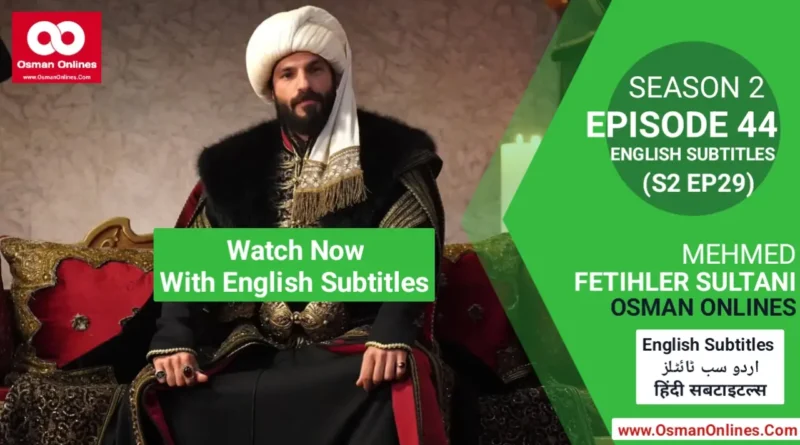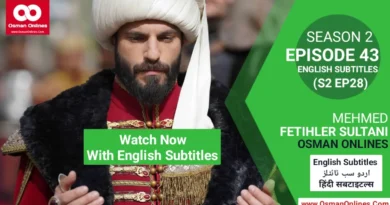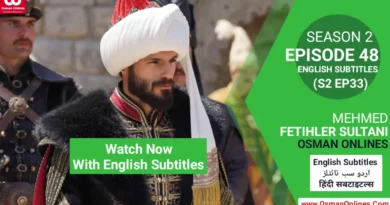Mehmed Fetihler Sultani Chapter 44: Recasting an Imperial Capital: Power, Patronage, and the Quiet Storm after Conquest
Mehmed Fetihler Sultani Chapter 44
Mehmed Fetihler Sultani Chapter 44
Introduction: a city remade and a ruler resolved
After the decisive conquest of Constantinople, the immediate task was not merely administration but reimagining a city that would bear the cultural and political imprint of a new age. Mehmed Fetihler Sultani Chapter 44 focuses on this crucial phase: the reconstruction of urban life, the consolidation of authority, and the subtle, often brutal, removal of long-standing threats that had shadowed the realm. Sultan Mehmed’s approach combined public works, political realignment, and decisive justice; behind the scenes, conspiracies and clandestine alliances threatened to upend his reforms. This chapter explores how leadership, patronage, and clandestine opposition intersected while the city’s stones were being laid.
1) Vision and urgency: rebuilding a capital for a new polity
Sultan Mehmed’s program for Constantinople was ambitious and urgent. Streets, markets, mosques, and public institutions required rapid transformation to make the city a functioning seat of power and a welcoming home for Muslim-Turkish families. The ruler understood that rebuilding physical infrastructure would be inseparable from reorganizing the state: administrative posts, military commands, and judicial offices had to be reassigned to sustain long-term stability. The chapter describes how large architectural projects especially a flagship mosque intended as a civic and spiritual center served both symbolic and practical ends, signaling continuity to inhabitants while reshaping identity.
2) Purges, justice, and political theatre
Consolidation of power required more than construction. Sultan Mehmed confronted a decades-long internal menace in the person of an aristocratic rival who had long destabilized the realm. The ruler’s response decisive, secretive, and final sent a clear message across court and provinces: no tolerated cabal would derail state-building. This dramatic resolution was both a judicial act and a political recalibration; it allowed Mehmed to appoint trusted officials, marginalize resistant elites, and accelerate reforms with reduced fear of conspiracy. The narrative shows how prudence and ruthlessness can operate in tandem when a ruler remodels institutions.
3) Patronage and the reshuffling of elites
Not all who sought promotion were equal to the demands of the new order. The chapter examines how established grandees some steeped in conservative habits faced disappointment as posts were redistributed to men of proven loyalty or demonstrated competence. Some prominent families adapted and rose to new heights; others found their influence curtailed. These personnel changes were vital: new prefects, judges, and administrators were essential to monetize the ruler’s vision, oversee construction, and regulate the increasingly diverse population. In many cases, appointments prioritized administrative skill and political fidelity over mere lineage.
4) The mosque as a political instrument and communal anchor
Foremost among the ruler’s public projects was the construction of a major mosque complex that would become a civic nucleus. Beyond ritual use, such complexes traditionally provided education, charity, legal arbitration, and a visible statement of political legitimacy. The chapter follows the mosque’s foundations, the selection of artisans, and the social expectations invested in the edifice. Yet the project also became the stage for a life-changing event: an incident at the construction site whether an accident, a betrayal, or an unforeseen tragedy deeply affected Sultan Mehmed and altered his outlook. That personal shock intensified his determination to ensure order and fidelity within the court.
5) Shadows in the palace: clandestine networks and ideological rivals
While public projects progressed, intellectual currents and secretive networks plotted in the margins. The chapter introduces certain influential figures scholars, retainers, and disaffected nobles who formed a covert circle aiming to shape the polity’s future to their own advantage. Their tactics relied on exploiting personal weaknesses, forging alliances across religious and ethnic lines, and staging disinformation. The account reveals how these conspirators used both cultural influence and strategic patience to challenge reforms. Yet Mehmed’s intelligence apparatus, guided by astute counselors, gradually exposed these plots and limited their reach.
6) Cultural exchange, learned patrons, and the interplay of traditions
The post-conquest period attracted émigrés, scholars, and craftsmen from various traditions. Sultan Mehmed sought to harness this influx to enrich the city’s institutions libraries, schools, and workshops creating a center of learning that blended Byzantine legacies with Ottoman patronage. The chapter highlights the role of prominent intellectuals who, though sometimes suspect in the eyes of the court, contributed to legal and philosophical debates that would influence policy. This interplay became a source of soft power an intellectual legitimacy that buttressed the ruler’s reforms and helped integrate diverse urban communities.
7) Administration, law, and the architecture of governance
Rebuilding a capital meant reorganizing governance down to the street level. The chapter outlines administrative reforms: clearer chains of command, enhanced tax and land surveys, and judicial reassignments designed to reduce corruption and increase responsiveness. It also describes the tension between centralizing impulses and the local notables’ desire for autonomy. The ruler’s strategy blended incentives land grants, official titles, and patronage with disciplinary measures for recalcitrant officials. A new bureaucratic rhythm began to emerge, one that would underpin the city’s prosperity for decades.
8) Social policy and urban demography: welcoming new inhabitants
Turning Constantinople into a durable Muslim-Turkish urban center required demographic planning. Sultan Mehmed encouraged settlement through incentives for artisans, farmers, and merchants, reconfiguring neighborhoods to balance economic needs and social cohesion. Public endowments were used to fund schools, hospitals, and markets; such institutions both eased the transition for newcomers and projected the state’s benevolence. The chapter traces how these policies changed the city’s texture: marketplaces grew livelier, educational institutions multiplied, and civic life became more varied and resilient.
9) Crises and the test of institutions
Large reconstruction programs inevitably produced crises: supply shortages, disputes over land, and outbreaks of unrest. The chapter narrates a series of flashpoints and how they tested the newly appointed administrators. Some crises were navigated through negotiation and compensation; others required firm enforcement of law. The sultan’s willingness to replace inefficient managers with competent agents proved decisive. These episodes illustrated that statecraft involves constant adaptation policy is refined in response to practical failure as much as ideological commitment.
10) Legacy and the making of a durable centre of power
By the chapter’s close, the seeds of a long-term transformation are visible. Architectural landmarks, newly structured institutions, and a reshuffled elite combined to create a city ready to function as the heart of an expanding polity. The ruler’s mixture of vision, administrative reorganization, and uncompromising action against internal threats made that future possible. The chapter leaves readers with the impression that building an imperial capital is as much about human management trust, surveillance, promotion, and punishment as it is about stone and mortar.
A concise timeline (table)
| Year (approx.) | Event | Significance |
|---|---|---|
| Immediately after conquest | Urban reconstruction begins | Symbolic and practical redefinition of capital |
| Early reform years | Removal of entrenched rival | Political consolidation and deterrence |
| During major mosque construction | Major incident affects the ruler | Strengthens resolve for reforms |
| Years following | Administrative reshuffle and settlement incentives | Foundation for long-term governance |
Select list: Key administrative actions taken
- Appointment of loyal, competent officials to major posts.
- Land surveys and regulatory reforms to stabilize revenue.
- Public endowments for education and charity to foster social cohesion.
- Strategic settlement policies to rebalance urban demographics.
Quote:
“A city is not merely a collection of buildings; it is the sum of its institutions and the trust between ruler and people.” — Narrative reflection from the chapter
Key takeaways
- Mehmed Fetihler Sultani Chapter 44 shows that the reconstruction of a capital requires simultaneous attention to buildings and people.
- Political consolidation often involves decisive, sometimes covert, measures against entrenched threats.
- Public works especially a major mosque complex functioned as both pragmatic infrastructure and political symbolism.
- Intellectual and cultural exchange enriched administrative reforms but also introduced new vectors of dissent.
- Effective governance after conquest relied on practical competence as much as ideological legitimacy.
Frequently Asked Questions (FAQ)
In Mehmed Fetihler Sultani Chapter 44, both themes are closely connected, showing how architectural efforts supported political legitimacy, social order, and identity formation.
In Mehmed Fetihler Sultani Chapter 44, the ruler’s decisions appear firm but not harsh, prioritizing stability and institutional survival during a delicate transition.
In Mehmed Fetihler Sultani Chapter 44, the population responded positively to settlement incentives, attracting craftsmen and merchants while naturally experiencing adjustments.
In Mehmed Fetihler Sultani Chapter 44, several scholars and artisans from diverse traditions play influential roles in shaping education and artistic life.
Yes. Mehmed Fetihler Sultani Chapter 44 offers clear explanations and balanced details, making it accessible to beginners and enriching for experienced history readers.
Conclusion: continuity through transformation
Mehmed Fetihler Sultani Chapter 44 offers a portrait of statecraft in motion: a ruler reshaping a conquered capital with deliberate acts of construction, personnel reform, and firm political judgment. The chapter argues that long-term stability was achieved not by a single grand gesture, but by a series of interlocking measures public works that inspired devotion and pride, administrative changes that improved governance, and targeted political actions that removed persistent threats. For readers of history, this chapter is a study in how leaders translate military success into lasting civic order, and how a city’s rebirth depends on both vision and the often-unseen calculus of power.




